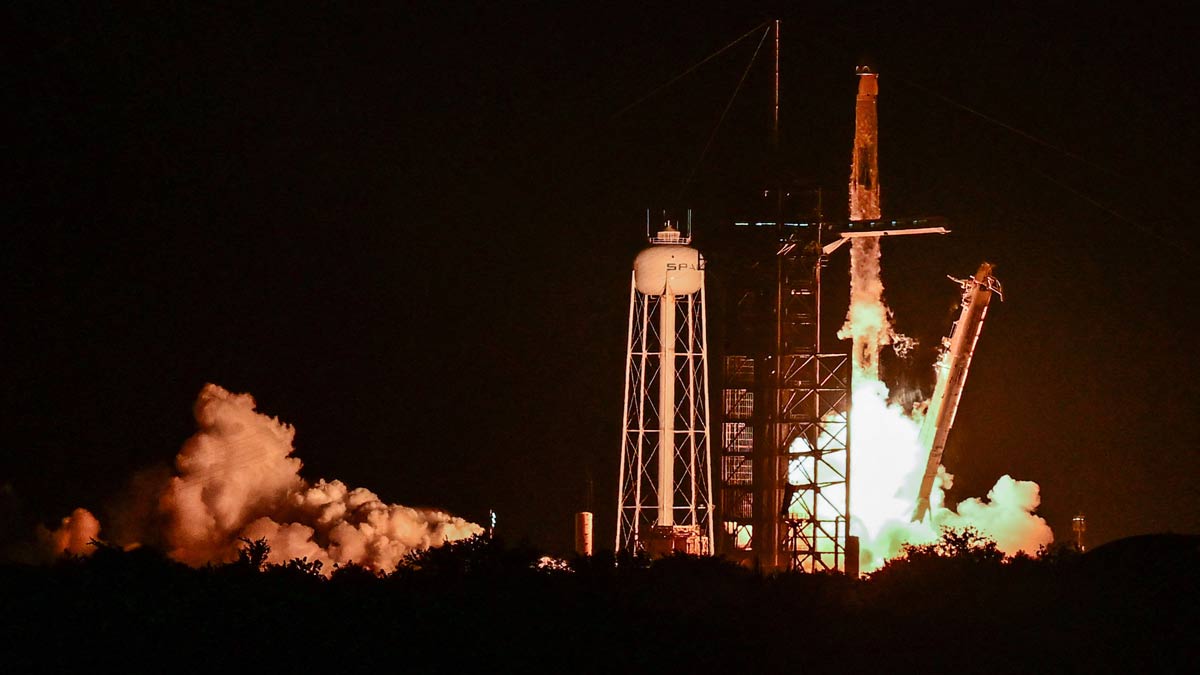Axiom Mission 4: 28.5 hours to cover 400km? A look at Dragon spacecraft’s path to ISS
 The Axiom-4 mission, with a SpaceX Dragon spacecraft and Falcon 9 rocket, lifts off from Launch Complex 39A at NASA's Kennedy Space Center in Cape Canaveral, Florida | AFP
The Axiom-4 mission, with a SpaceX Dragon spacecraft and Falcon 9 rocket, lifts off from Launch Complex 39A at NASA's Kennedy Space Center in Cape Canaveral, Florida | AFP
The Axiom Mission 4 (Ax-4) launched successfully today, June 25 at 12:01 PM IST (2:31 AM EDT) from NASA’s Kennedy Space Center in Florida. This mission is a major moment for India, Poland, and Hungary, as it marks their return to human spaceflight after more than 40 years. It is the fourth private astronaut mission to the International Space Station (ISS), and highlights growing international collaboration in space.
The crew of Ax-4 includes American astronaut Peggy Whitson as commander, Indian Air Force officer and ISRO representative Group Captain Shubhanshu Shukla as pilot, and mission specialists Sławosz Uznański-Wiśniewski from Poland and Tibor Kapu from Hungary. They are flying on a brand-new SpaceX Crew Dragon spacecraft launched on a Falcon 9 rocket.
ALSO READ: How Group Captain Shubhanshu Shukla became the face of India’s return to space
Even though the ISS is only about 400 kilometres above Earth, the Dragon capsule takes around 28.5 hours to reach it. This is because the spacecraft must follow careful flight paths and safety rules. After lift-off, Dragon separates from the rocket, checks its systems, and starts performing several engine burns to slowly raise its orbit and catch up with the space station.
“These burns include gradual adjustments to its speed and altitude,” explained Srimathy Kesan, founder and CEO of Space Kidz India. “Step by step, Dragon moves into position, getting closer to the ISS using complex manoeuvres. These include the Phase Burn, Boost Burn, and Coelliptic Burns that allow the capsule to approach in a safe and controlled way. As it reaches near the ISS, the Dragon spacecraft begins its final approach. It communicates with the station, lines up correctly, and moves in very slowly. At a distance of 20 metres, the crew checks everything before getting permission to dock. The docking happens in two stages: first a soft contact, and then a hard capture using mechanical hooks to fully attach the spacecraft to the station.”
ALSO READ: Humans on International Space Station: 25 years, and counting...
Docking is expected around 4:30pm IST on June 26. Leak checks and pressure tests will be done then to ensure the connection is safe. Then the hatch will open, and the Ax-4 astronauts will enter the ISS. They will be welcomed by the current crew and given safety instructions.
The crew will stay on the space station for 14 days. During this time, they will conduct more than 60 scientific studies from 31 different countries. These include research in human health, Earth observation, biology, material science, and space education. Several experiments are being done in collaboration with NASA and ISRO.
This mission is not only about science. The astronauts will also take part in educational outreach and commercial activities. With participation from countries like the USA, India, Poland, Hungary, Saudi Arabia, Brazil, Nigeria, and the UAE, Ax-4 shows how international partnerships can make space more accessible. It’s a big step forward in private space missions and opens the door for more global participation in space exploration.
ALSO READ: 'We are normalising access to ISS': Chief astronaut Michael López-Alegría, Axiom Space
"We are proud and happy to see Shubhanshu Shukla become the second Indian to travel to space, this time as part of the Axiom-4 Mission,” said Lt. Gen. AK Bhatt (retd.), Director General, Indian Space Association (IspA). “This journey is a testament to the growing global footprint of India in space exploration and is a stepping stone to what we want to achieve with Gaganyaan, our own indigenous human spaceflight programme. India is now in the final stages of preparation for the Gaganyaan mission, with firms like Larsen & Toubro, Tata and Ananth Technologies playing a critical role alongside our vibrant startups. If all goes as planned, we are just one or two years away from realising the dream of sending Indian astronauts to space on an entirely indigenous platform. The success of missions like Axiom-4 inspires our ecosystem and strengthens our resolve to make India a leading force in the new era of space exploration."
Sci/Tech